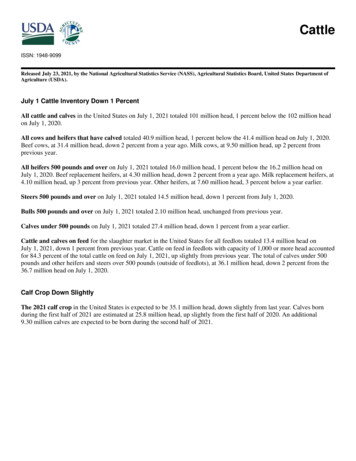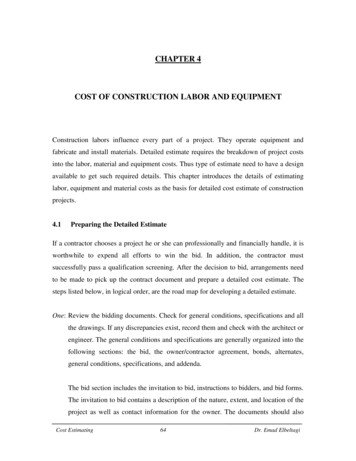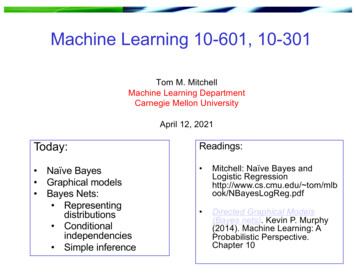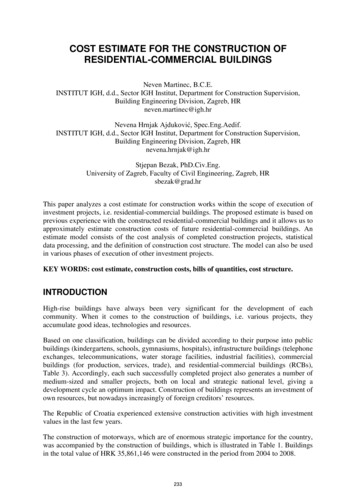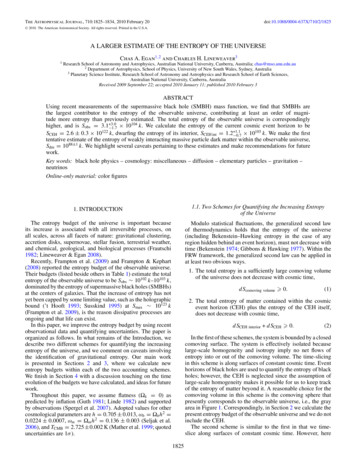
Transcription
The Astrophysical Journal, 710:1825–1834, 2010 February 20 C 2010.doi:10.1088/0004-637X/710/2/1825The American Astronomical Society. All rights reserved. Printed in the U.S.A.A LARGER ESTIMATE OF THE ENTROPY OF THE UNIVERSEChas A. Egan1,2 and Charles H. Lineweaver31Research School of Astronomy and Astrophysics, Australian National University, Canberra, Australia; chas@mso.anu.edu.au2 Department of Astrophysics, School of Physics, University of New South Wales, Sydney, Australia3 Planetary Science Institute, Research School of Astronomy and Astrophysics and Research School of Earth Sciences,Australian National University, Canberra, AustraliaReceived 2009 September 22; accepted 2010 January 11; published 2010 February 3ABSTRACTUsing recent measurements of the supermassive black hole (SMBH) mass function, we find that SMBHs arethe largest contributor to the entropy of the observable universe, contributing at least an order of magnitude more entropy than previously estimated. The total entropy of the observable universe is correspondingly104higher, and is Sobs 3.1 3.0k. We calculate the entropy of the current cosmic event horizon to be 1.7 10103SCEH 2.6 0.3 10122 k, dwarfing the entropy of its interior, SCEH int 1.2 1.1k. We make the first 0.7 10tentative estimate of the entropy of weakly interacting massive particle dark matter within the observable universe,Sdm 1088 1 k. We highlight several caveats pertaining to these estimates and make recommendations for futurework.Key words: black hole physics – cosmology: miscellaneous – diffusion – elementary particles – gravitation –neutrinosOnline-only material: color figures1. INTRODUCTION1.1. Two Schemes for Quantifying the Increasing Entropyof the UniverseThe entropy budget of the universe is important becauseits increase is associated with all irreversible processes, onall scales, across all facets of nature: gravitational clustering,accretion disks, supernovae, stellar fusion, terrestrial weather,and chemical, geological, and biological processes (Frautschi1982; Lineweaver & Egan 2008).Recently, Frampton et al. (2009) and Frampton & Kephart(2008) reported the entropy budget of the observable universe.Their budgets (listed beside others in Table 1) estimate the totalentropy of the observable universe to be Sobs 10102 k–10103 k,dominated by the entropy of supermassive black holes (SMBHs)at the centers of galaxies. That the increase of entropy has notyet been capped by some limiting value, such as the holographicbound (’t Hooft 1993; Susskind 1995) at Smax 10123 k(Frampton et al. 2009), is the reason dissipative processes areongoing and that life can exist.In this paper, we improve the entropy budget by using recentobservational data and quantifying uncertainties. The paper isorganized as follows. In what remains of the Introduction, wedescribe two different schemes for quantifying the increasingentropy of the universe, and we comment on caveats involvingthe identification of gravitational entropy. Our main workis presented in Sections 2 and 3, where we calculate newentropy budgets within each of the two accounting schemes.We finish in Section 4 with a discussion touching on the timeevolution of the budgets we have calculated, and ideas for futurework.Throughout this paper, we assume flatness (Ωk 0) aspredicted by inflation (Guth 1981; Linde 1982) and supportedby observations (Spergel et al. 2007). Adopted values for othercosmological parameters are h 0.705 0.013, ωb Ωb h2 0.0224 0.0007, ωm Ωm h2 0.136 0.003 (Seljak et al.2006), and TCMB 2.725 0.002 K (Mather et al. 1999; quoteduncertainties are 1σ ).Modulo statistical fluctuations, the generalized second lawof thermodynamics holds that the entropy of the universe(including Bekenstein–Hawking entropy in the case of anyregion hidden behind an event horizon), must not decrease withtime (Bekenstein 1974; Gibbons & Hawking 1977). Within theFRW framework, the generalized second law can be applied inat least two obvious ways.1. The total entropy in a sufficiently large comoving volumeof the universe does not decrease with cosmic time,dScomoving volume 0.(1)2. The total entropy of matter contained within the cosmicevent horizon (CEH) plus the entropy of the CEH itself,does not decrease with cosmic time,dSCEH interior dSCEH 0.(2)In the first of these schemes, the system is bounded by a closedcomoving surface. The system is effectively isolated becauselarge-scale homogeneity and isotropy imply no net flows ofentropy into or out of the comoving volume. The time-slicingin this scheme is along surfaces of constant cosmic time. Eventhorizons of black holes are used to quantify the entropy of blackholes; however, the CEH is neglected since the assumption oflarge-scale homogeneity makes it possible for us to keep trackof the entropy of matter beyond it. A reasonable choice for thecomoving volume in this scheme is the comoving sphere thatpresently corresponds to the observable universe, i.e., the grayarea in Figure 1. Correspondingly, in Section 2 we calculate thepresent entropy budget of the observable universe and we do notinclude the CEH.The second scheme is similar to the first in that we timeslice along surfaces of constant cosmic time. However, here1825
1826EGAN & LINEWEAVERFigure 1. Panels show the particle horizon (see Equation (A1) and Figure 9)and the cosmic event horizon (see Equation (A5)) as a function of time. Thedifference between the two panels is the spatial coordinate system used: the xaxis in the bottom panel is proper distance D and in the top panel it is comovingdistance χ Da , where a is the cosmic scalefactor. The origin is chosen so thatour galaxy is the central vertical dotted line. The other dotted lines representdistant galaxies, which are approximately comoving and recede as the universeexpands. The region inside the particle horizon is the observable universe. Thecomoving volume that corresponds to the observable universe today, about13.7 Gyr after the big bang, is filled gray. In scheme 1, the entropy within thiscomoving volume increases (or remains constant) with time. Alternatively, inscheme 2 the entropy within the event horizon (the region filled yellow), plusthe entropy of the horizon itself, increases (or remains constant) with time.(A color version of this figure is available in the online journal.)the system (yellow shade in Figure 1) is bounded by the timedependent CEH instead of a comoving boundary. Migration ofmatter across the CEH is not negligible, and the CEH entropy(Gibbons & Hawking 1977) must be included in the budget toaccount for this (e.g., Davis et al. 2003). The present entropy ofthe CEH and its interior is calculated in Section 3.1.2. Entropy and GravityIt is widely appreciated that non-gravitating systems ofparticles evolve toward homogenous temperature and density distributions. The corresponding increase in the volumeof momentum-space and position-space occupied by the constituent particles represents an increase in entropy. On the otherhand, strongly gravitating systems become increasingly lumpy.With “lumpyness” naively akin to “orderliness,” it is not as easyto see that the total entropy increases. In these systems, the entropy is shared among numerous components, all of which mustbe considered.For example, approximately collisionless long-range gravitational interactions between stars result in dynamical relaxationof galaxies (Lynden-Bell 1967; whereby bulk motions are dissipated and entropy is transferred to stars in the outer regionsof the galaxy) and stellar evaporation from galaxies (wherebystars are ejected altogether, carrying with them energy, angularmomentum, and entropy, and allowing what remains behind tocontract; e.g., Binney & Tremaine 2008). In more highly dissipative systems, i.e., accretion disks, non-gravitational interac-Vol. 710tions (viscosity and/or magnetorotational instability; Balbus &Hawley 2002) transfer angular momentum and dissipate energyand entropy.In addition to these considerations, entropy also increaseswhen gravitons are produced. A good example is the in-spiralof close binaries, such as the Hulse–Taylor binary pulsar system(Hulse & Taylor 1975; Weisberg & Taylor 2005). Gravitationalwaves emitted from the system extract orbital energy (andtherefore entropy) allowing the system to contract.The entropy of a general gravitational field is still not known.Penrose (1987, 1979, 2004) has proposed that it is related to theWeyl curvature tensor Wμνκλ . In conformally flat spacetimes(such as an ideal FRW universe), the Weyl curvature vanishesand gravitational entropy is postulated to vanish (to limitsimposed by quantum uncertainty). In clumpy spacetimes, theWeyl curvature takes large values and the gravitational entropyis high. While Ricci curvature Rμν vanishes in the absence ofmatter, Weyl curvature may still be non-zero (e.g., gravitationalwaves traveling though empty space) and the correspondinggravitational entropy may be non-zero.If these ideas are correct then the low gravitational entropyof the early universe comes from small primordial gravitational perturbations. Gravitational entropy then increases withthe growing amplitude of linear density fluctuations parameterized through the matter power spectrum P (k). The presentgravitational entropy, however, is expected to be dominated bythe nonlinear overdensities (with large Weyl tensors) which haveformed since matter-radiation equality.In extreme cases, gravitational clumping leads to the formation of black holes. The entropy of black holes is well known(Bekenstein 1973; Hawking 1976; Strominger & Vafa 1996).The entropy of a Schwarzschild black hole is given bySBH 24π kG 2kc3 A M ,Gh̄ 4ch̄(3)2Mwhere A 16πGis the event-horizon area and M is the blackc4hole mass.Because gravitational entropy is difficult to quantify, weonly include it in the two extremes: the thermal distributionof gravitons and black holes.2. THE PRESENT ENTROPY OF THEOBSERVABLE UNIVERSEThe present entropy budget of the observable universe wasestimated most recently by Frampton et al. (2009) and Frampton& Kephart (2008). These papers and earlier work (Kolb &Turner 1981; Frautschi 1982; Penrose 2004; Bousso et al.2007) identified the largest contributors to the entropy ofthe observable universe as black holes, followed distantly bythe cosmic microwave background (CMB) and the neutrinobackground. The last column of Table 1 contains previousestimates of the entropy in black holes, the CMB and neutrinos,as well as several less significant components.Sections 2.1–2.7 below describe the data and assumptionsused to calculate our entropy densities (given in Column 2of Table 1). Our entropy budget for the observable universe(Column 3 of Table 1) is then found by multiplying the entropydensity by the volume of the observable universe Vobs ,Si si Vobs ,(4)
No. 2, 2010LARGER ESTIMATE OF THE ENTROPY OF THE UNIVERSEwhere si is the entropy density of component i. The volume ofthe observable universe is (see the Appendix)Vobs 43.2 1.2 104 Glyr3 3.65 0.10 1080 m3 .(5)For a non-relativistic, non-degenerate gas, the specific entropy(entropy per baryon) is given by the Sakur–Tetrode equation(e.g., Basu & Lynden-Bell 1990) k 35 3, (6)ni ln Zi (T )(2π mi kT ) 2 e 2 n 1i hnb iwhere i indexes particle types in the gas, ni is the ith particle type’s number density, and Zi (T ) is its internal partitionfunction. Basu & Lynden-Bell (1990) found specific entropiesbetween 11 k and 21 k per baryon for main-sequence stars ofapproximately solar mass. For components of the interstellarmedium (ISM) and intergalactic medium (IGM), they foundspecific entropies between 20 k (H2 in the ISM) and 143 k (ionized hydrogen in the IGM) per baryon.The cosmic entropy density in stars s can be estimated bymultiplying the specific entropy of stellar material by the cosmicnumber density of baryons in stars nb :s (s/nb ) nb (s/nb ) The entropy of the CMB is calculated using the equation fora black body (e.g., Kolb & Turner 1990),2π 2 k 4gγ Tγ345 c3h̄3 1.478 0.003 109 k m 3 ,(12)Sγ 2.03 0.15 1089 k,(13)sγ 2.1. Baryons(s/nb ) 1827 3H 2 Ω ρ . (7) (s/nb ) mp8π G mpUsing the stellar cosmic density parameter Ω 0.0027 0.0005 (Fukugita & Peebles 2004) and the range of specificentropies for main-sequence stars around the solar mass (whichdominate stellar mass), we finds 0.26 0.12 k m 3 ,(8)S 9.5 4.5 1080 k.(9)Similarly, the combined energy density for the ISM and IGM isΩgas 0.040 0.003 (Fukugita & Peebles 2004), and by usingthe range of specific entropies for ISM and IGM components,we findsgas 20 15 k m 3 ,(10)Sgas 7.1 5.6 1081 k.(11)where gγ 2 is the number of photon spin states. Theuncertainty in Equation (13) is dominated by uncertainty inthe size of the observable universe.The non-CMB photon contribution to the entropy budget(including starlight and heat emitted by the ISM) is somewhatless, at around 1086 k (Frautschi 1982; Bousso et al. 2007;Frampton et al. 2009).2.3. Relic NeutrinosThe neutrino entropy cannot be calculated directly sincethe temperature of cosmic neutrinos has not been measured.Standard treaties of the radiation era (e.g., Kolb & Turner1990; Peacock 1999) describe how the present temperature (andentropy) of massless relic neutrinos can be calculated from thewell-known CMB photon temperature. Since this backgroundphysics is required for Sections 2.4 and 2.5, we summarize itbriefly here.A simplifying feature of the radiation era (at least at knownenergies 1012 eV) is that the radiation fluid evolves adiabatically: the entropy density decreases as the cube of the increasingscalefactor, srad a 3 . The evolution is adiabatic because reaction rates in the fluid are faster than the expansion rate H of theuniverse. It is convenient to write the entropy density assrad 2π 2 k 4g S Tγ3 a 3 ,45 c3h̄3where g S is the number of relativistic degrees of freedom inthe fluid (with m kT /c2 ) given approximately by 3 7 Tj 3Tigjg S (T ) gi . (15)Tγ8Tγbosons, ifermions, jFor photons alone, g S gγ 2, and thus Equation (14)becomes Equation (12). For photons coupled to an electron–positron component, such as existed before electron–positronannihilation, g S gγ 78 ge 2 78 4 112 .As the universe expands, massive particles annihilate, heatingthe remaining fluid. The effect on the photon temperature isquantified by inverting Equation (14), 1/3The uncertainties in Equations (9) and (11) are dominated byuncertainties in the mass weighting of the specific entropies, butalso include uncertainties in Ω , Ωgas , and the volume of theobservable universe.2.2. PhotonsThe CMB photons are the most significant non-black holecontributors to the entropy of the observable universe. Thedistribution of CMB photons is thermal (Mather et al. 1994)with a present temperature of Tγ 2.725 0.002 K (Matheret al. 1999).(14)Tγ a 1 g S .(16)The photon temperature decreases less quickly than a 1 becauseg S decreases with time. Before electron–positron e annihilation, the temperature of the photons was the same as that of thealmost completely decoupled neutrinos. After e annihilationheats only the photons, the two temperatures differ by a factorC,Tν C Tγ .(17)A reasonable approximation, C (4/11)1/3 , is derived byassuming that only photons were heated during e annihilation,
1828EGAN & LINEWEAVERVol. 710where 4/11 is the ratio of g S for photons to g S for photons,electrons, and positrons.Corrections are necessary at the 10 3 level because neutrinoshad not completely decoupled at e annihilation (Gnedin& Gnedin 1998). The neutrino entropy density is computedassuming a thermal distribution with Tν (4/11)1/3 Tγ , and weassign a 1% uncertainty. 72π 2 k 4Tν3sν gν45 c3h̄38 1.411 0.014 109 k m 3 ,(18)where gν 6 (3 flavors, 2 spin states each). The total neutrinoentropy in the observable universe is thenSν 5.16 0.14 1089 k(19)with an uncertainty dominated by uncertainty in the volume ofthe observable universe.Neutrino oscillation experiments have demonstrated thatneutrinos are massive by measuring differences between thethree neutrino mass eigenstates (Cleveland et al. 1998; Adamsonet al. 2008; Abe et al. 2008). At least two of the mass eigenstatesare heavier than 0.009 eV. Since this is heavier than theircurrent relativistic energy ( k2 CTγ 0.0001 eV; computed underthe assumption that they are massless) at least two of the threemasses are presently non-relativistic.Expansion causes non-relativistic species to cool as a 2 instead of a 1 , which would result in a lower temperature forthe neutrino background than suggested by Equation (17). Theentropy density (calculated in Equation (18)) and entropy (calculated in Equation (19)) are unaffected by the transition tonon-relativistic cooling since the cosmic expansion of relativistic and non-relativistic gases are both adiabatic processes (thecomoving entropy is conserved, so in either case s a 3 ).We neglect a possible increase in neutrino entropy due to theirinfall into gravitational potentials during structure formation. Iflarge, this will need to be considered in future work.2.4. Relic GravitonsA thermal background of gravitons is expected to exist, whichdecoupled from the photon bath around the Planck time, and hasbeen cooling as Tgrav a 1 since then. The photons cooled lessquickly because they were heated by the annihilation of heavyparticle species (Equation (16)). Thus, we can relate the currentgraviton temperature to the current photon temperature Tgrav g S (t0 )g S (tplanck ) 1/3Tγ ,(20)where g S (tplanck ) is the number of relativistic degrees of freedomat the Planck time and g S (t0 ) 3.91 today (this is appropriateeven in the case of massive neutrinos because they decoupledfrom the photon bath while they were still relativistic). Giventhe temperature of background gravitons, their entropy can becalculated assgrav 2π 2 k 43ggrav Tgrav,45 c3h̄3(21)where ggrav 2.Figure 2 shows g S as a function of temperature. The function is well known for temperatures below about 1012 eV,Figure 2. Number of relativistic degrees of freedom g S as a function oftemperature, computed using the prescription given by Coleman & Roos (2003).All the particles of the standard model are relativistic at T 1012 eV andg S (1012 eV) 106.75. The value of g S is not known above T 1012 . Toestimate plausible ranges of values, we extrapolate g S linearly (gray line) andexponentially (thin blue line) in log(T ). The minimum contribution to g S fromsupersymmetric partners is shown (blue bar) and taken to indicate a minimumlikely value of g S at higher temperatures (thick blue line).(A color version of this figure is available in the online journal.)but is not known at higher temperatures. Previous estimates of the background graviton entropy have assumedg S (tplanck ) g S (1012 eV) 106.75 (Frampton et al. 2009;Frampton & Kephart 2008), but this should be taken as alower bound on g S (tplanck ) yielding an upper bound on Tgravand sgrav .To get a better idea of the range of possible gravitontemperatures and entropies, we have adopted three values forg S (tplanck ). As a minimum likely value, we use g S 200(Figure 2, thick blue line), which includes the minimal setof additional particles suggested by supersymmetry. As ourmiddle value we use g S 350, corresponding to the linearextrapolation of g S in log(T ) to the Planck scale (Figure 2,gray line). And as a maximum likely value we use g S 105 ,corresponding to an exponential extrapolation (Figure 2, thinblue line).The corresponding graviton temperatures today are(Equation (20))Tgrav 0.61 0.12 0.52 K.(22)Inserting this into Equation (21), we find the entropy in the relicgraviton background to be
No. 2, 2010LARGER ESTIMATE OF THE ENTROPY OF THE UNIVERSE7 0.2 2.5sgrav 1.7 10k m 3 , 0.2Sgrav 6.2 1087 2.5 k.1829(23)(24)It is interesting to note the possibility of applyingEquation (20) in reverse, i.e., calculating the number of relativistic degrees of freedom at the Planck time using futuremeasurements of the graviton background temperature.2.5. Dark MatterThe most compelling interpretation of dark matter is as aweakly interacting superpartner (or weakly interacting massiveparticle, WIMP). According to this idea, dark matter particlesdecoupled from the radiation background at some energy abovethe particle mass.If this interpretation is correct, the fraction of relativisticbackground entropy in dark matter at the time dark matterdecoupled tdm dec is determined by the fraction of relativisticdegrees of freedom that were associated with dark matter at thattime (see Equation (14)),sdm g S dm (tdm dec )snon-dm rad .g S non-dm (tdm dec )(25)This can be evaluated at dark matter decoupling, or anytime thereafter, since both sdm and snon dm rad are adiabatic( a 3 ).We are unaware of any constraint on the number of superpartners that may collectively constitute dark matter. The requirements that they are only weakly interacting, and that they decouple at a temperature above their mass, are probably only satisfiedby a few (even one) species. Based on these arguments, we assume g S dm (tdm dec ) 20 and g S (tdm dec ) 106.75 whichyields the upper limit1g S dm (tdm dec ) .g S (tdm dec )5(26)On the other hand, there may be many more degrees offreedom than suggested by minimal supersymmetry. By extrapolating g S exponentially beyond supersymmetric scales(to 1015 eV), we find g S (tdm dec ) 800. In the simplest case,dark matter is a single scalar particle so g S dm (tdm dec ) 1 andwe take as a lower limitg S dm (tdm dec )1 .g S non dm (tdm dec )800(27)Inserting this into Equation (25) at the present day givessdm 5 107 1 k m 3 ,(28)where we have used the estimated limits given in Equations (26)and (27) and taken snon-dm rad to be the combined entropy ofneutrinos and radiation today (Equations (12) and (18)). Thecorresponding estimate for the total dark matter entropy in theobservable universe isSdm 2 1088 1 k.(29)As with our calculated neutrino entropy, our estimates herecarry the caveat that we have not considered changes in the darkmatter entropy associated with gravitational structure formation.Figure 3. Progenitors in the IMF (top panel) evolve into the distribution ofremnants in the bottom panel. The shape of the present main-sequence massfunction differs from that of the IMF (top panel) by the stars that have diedleaving white dwarfs (yellow), neutron stars (blue), and black holes (lightand dark gray). The present distribution of remnants is shown in the bottompanel. Black holes in the range 2.5 M M 15 M (light gray) havebeen observationally confirmed. They form from progenitors in the range25 M M 42 M via core collapse supernova and fallback, and we 0.6calculate their entropy to be 5.9 1097 1.2 k. Progenitors above about 42 M ,may evolve directly to black holes without significant loss of mass (dark gray)and may carry much more entropy, but this population has not been observed.The green curve, whose axis is on the right, shows the mass distribution ofstellar black hole entropies in the observable universe.(A color version of this figure is available in the online journal.)2.6. Stellar Black HolesIn the top panel of Figure 3, we show the stellar initial massfunction (IMF) parameterized bydninitial d log M MM α 1,(30)with α 1.35 at M 0.5 M and α 2.35 0.65 0.35 atM 0.5 M (Elmegreen 2007). We also show the presentdistribution of main-sequence stars, which is proportional tothe initial distribution for M 1 M , but which is reduced bya factor of (M/M ) 2.5 for heavier stars (Fukugita & Peebles2004), initial ddn,for M 1 M dnpresentlog(M). (31) dninitial M 2.5d log(M) , for M 1 M d log(M)M The initial and present distributions are normalized usingthe present cosmic density of stars, Ω 0.0027 0.0005(Fukugita & Peebles 2004).The yellow fill in the top panel represents stars of mass1 M M 8 M , which died leaving white dwarf remnantsof mass M 1.4 M (yellow fill, bottom panel). The blue fillrepresents stars of mass 8 M M 25 M , which died andleft neutron star remnants of mass 1.4 M M 2.5 M . Thelight gray area represents stars of mass 25 M M 42 M ,which became black holes of mass 2.5 M M 15 M viasupernovae (here we use the simplistic final-initial mass function
1830EGAN & LINEWEAVERVol. 710Table 1Current Entropy of the Observable Universe (Scheme 1 Entropy Budget)Entropy Density s (k m 3 )Component8.4 8.2 4.7SMBHs 10233.1 3.0 1.710101 [1], 10102 [2], 10103 [3]97 0.6 1.21097 [2], 1098 [4]1088 [1, 2, 4], 1089 [5]1088 [2],1089 [5].5.9 105.40 0.15 10895.16 0.15 10892 1088 11.7 107 2.520 150.26 0.12 0.26.2 1087 2.57.1 5.6 10819.5 4.5 10801086 [2, 3].1079 [2]238.4 8.2 4.7 101043.1 3.0 1.7 1010101 [1], 10102 [2], 10103 [3]10251010610106 [6]Relic GravitonsISM and IGMStarsTotalEntropy S (k) (Previous Work) 1010417 0.6 1.21.6 101.478 0.003 1091.411 0.014 1095 107 1Stellar BHs (2.5–15 M )PhotonsRelic NeutrinosWIMP Dark MatterEntropy S (k)Tentative Components:Massive Halo BHs (105 M )8.5 10Stellar BHs (42–140 M ) 0.218 0.8 1.63.1 1099 0.8 1.6.Notes. Our budget is consistent with previous estimates from the literature with the exception that SMBHs, which dominate the budget, contain atleast an order of magnitude more entropy as previously estimated, due to the contributions of black holes 100 times larger than those consideredin previous budgets. Uncertainty in the volume of the observable universe (see the Appendix) has been included in the quoted uncertainties.Massive halo black holes at 105 M and stellar black holes in the range 42–140 M are included tentatively since their existence is speculative.They are not counted in the budget totals. Previous work: (1) Penrose 2004, (2) Frampton et al. 2009, (3) Frampton & Kephart 2008, (4) Frautschi1982, (5) Kolb & Turner 1981, (6) Frampton 2009b.of Fryer & Kalogera (2001)). Stars larger than 42 M collapsedirectly to black holes, without supernovae, and therefore retainmost of their mass (dark gray regions; Fryer & Kalogera 2001;Heger et al. 2005).Integrating Equation (3) over stellar black holes in the rangeM 15 M (the light gray fill in the bottom panel of Figure 3),we findsSBH (M 15 M ) 1.6 1017 1.2 k m 3 , 0.6 0.6SSBH (M 15 M ) 5.9 1097 1.2 k,(32)(33)which is comparable to previous estimates of the stellar blackhole entropy (see Table 1). Our uncertainty is dominated byuncertainty in the slope of the IMF, but also includes uncertaintyin the normalization of the mass functions and uncertainty inthe volume of the observable universe.If the IMF extends beyond M 42 M as in Figure 3,then these higher mass black holes (the dark gray fill in thebottom panel of Figure 3) may contain more entropy than blackholes of mass M 15 M (Equation (32)). For example, if theSalpeter IMF is reliable to M 140 M (the Eddington limitand the edge of Figure 3), then black holes in the mass range 0.842–140 M would contribute about 3.1 1099 1.6 k to the entropyof the observable universe. Significantly less is known aboutthis potential population, and should be considered a tentativecontribution in Table 1.2.7. Supermassive Black HolesPrevious estimates of the SMBH entropy (Penrose 2004;Frampton et al. 2009; Frampton & Kephart 2008) have assumeda typical SMBH mass and a number density and yield SSMBH 10101 –10103 k. Below we use the SMBH mass function asmeasured recently by Graham et al. (2007). Assuming a threeparameter Schechter functiondn φ d log M MM α 1 M,exp 1 M (34)Figure 4. The entropy of supermassive black holes. The black curve, whose axisis on the left, is the SMBH mass function from Graham et al. (2007), i.e., thenumber of supermassive black holes per Mpc3 per logarithmic mass interval.The green curve, whose axis is on the right, shows the mass distribution ofSMBH entropies in the observable universe.(A color version of this figure is available in the online journal.)(number density per logarithmic mass interval) they findφ 0.0016 0.0004 Mpc 3 , M 2.9 0.7 108 M ,and α 0.30 0.04. The data and best-fit model are shownin black in Figure 4.We calculate the SMBH entropy density by integratingEquation (3) over the SMBH mass function, 4π kGdnd log M.(35)s M2ch̄d log(M)The integrand is plotted using a green line in Figure 4 showingthat the contributions to SMBH entropy are primarily due toblack holes around 109 M . The SMBH entropy is found tobe23 3sSMBH 8.4 8.2 4.7 10 k m ,(36)104k.SSMBH 3.1 3.0 1.7 10(37)
No. 2, 2010LARGER ESTIMATE OF THE ENTROPY OF THE UNIVERSE1831Table 2Entropy of the Event Horizon and the Matter Within It(Scheme 2 Entropy Budget)ComponentEntropy S (k)2.6 0.3 101221031.2 1.1 0.7 10Cosmic Event HorizonSMBHsStellar BHs (2.5–15 M )PhotonsRelic NeutrinosWIMP Dark MatterFigure 5. Comparing the entropic contributions of black holes of differentmasses. Whether or not the total black hole entropy is dominated by SMBHsdepends on the yet-unquantified number of intermediate mass black holes.(A color version of this figure is available in the online journal.)The uncertainty here includes uncertainties in the SMBH massfunction and uncertainties in the volume of the observableuniverse. This is at least an order of magnitude larger thanprevious estimates (see Table 1). The reason for the differenceis that the (Graham et al. 2007) SMBH mass function containslarger black holes than assumed in previous estimates.Frampton (2009a, 2009b) has suggested that intermediatemass black holes in galactic halos may contain more entropythan SMBHs in galactic cores. For example, according to themassive astrophysical compact halo object (MACHO) explanation of dark matter, intermediate mass black holes in themass range 102
holes; however, the CEH is neglected since the assumption of large-scale homogeneity makes it possible for us to keep track of the entropy of matter beyond it. A reasonable choice for the comoving volume in this scheme is the comoving sphere that presently corresponds to the observable universe, i.e., the gray area in Figure 1.



